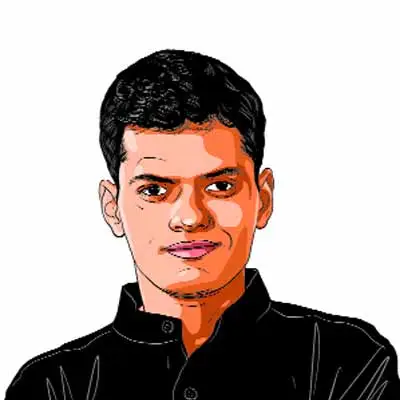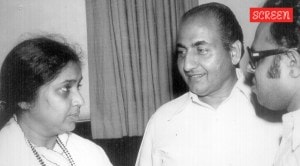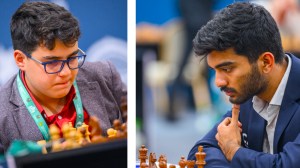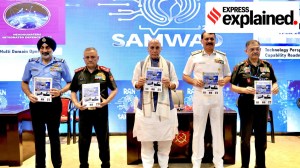Shubhajit Roy, Diplomatic Editor at The Indian Express, has been a journalist for more than 25 years now. Roy joined The Indian Express in October 2003 and has been reporting on foreign affairs for more than 17 years now. Based in Delhi, he has also led the National government and political bureau at The Indian Express in Delhi — a team of reporters who cover the national government and politics for the newspaper. He has got the Ramnath Goenka Journalism award for Excellence in Journalism ‘2016. He got this award for his coverage of the Holey Bakery attack in Dhaka and its aftermath. He also got the IIMCAA Award for the Journalist of the Year, 2022, (Jury’s special mention) for his coverage of the fall of Kabul in August 2021 — he was one of the few Indian journalists in Kabul and the only mainstream newspaper to have covered the Taliban’s capture of power in mid-August, 2021. ... Read More
How Trump’s pro-Russia turn has left Ukraine, Europe ‘stunned’
US and Russia are negotiating the end of the war in Ukraine, with neither Ukrainians nor Europeans at the table. As Donald Trump upends the eight-decade-old US-Europe partnership, what is the view from Delhi?
 President Volodymyr Zelenskyy of Ukraine (left) with US President Donald Trump in New York last September. (The New York Times)
President Volodymyr Zelenskyy of Ukraine (left) with US President Donald Trump in New York last September. (The New York Times)A well-known saying, frequently attributed to Vladimir Lenin, goes: “There are decades when nothing happens, and there are weeks when decades happen.” This past week could qualify for the latter category.
On February 18, a high-level delegation of ministers and officials from the United States and Russia met in Riyadh, Saudi Arabia, for the first in-person contact between Washington and Moscow since Russia invaded Ukraine three years ago.
A path for the beginning of negotiations was cleared days earlier — on February 12, US President Donald Trump had a “highly productive” 90-minute conversation over the phone with Russia’s President Vladimir Putin.
Hardtalk in Europe
Two important developments followed the Trump-Putin call.
First, Secretary of Defense Pete Hegseth asked the Ukraine Defense Contact Group in Brussels to recognise that “returning to Ukraine’s pre-2014 borders” was “unrealistic”.
The US “does not believe that NATO membership for Ukraine” was “realistic”, Hegseth also said.
Second, Vice President J D Vance told European leaders at the Munich Security Conference that the main threat to Europe was not from Russia, but from within. “If you are running in fear of your own voters, there is nothing America can do for you,” he said.
These remarks — the ones by Vance were described as a “lecture” that “stunned” the Europeans — foreshadowed the meeting that two other senior members of the Trump cabinet, Secretary of State Marco Rubio and National Security Advisor Mike Waltz, had with the Russian delegation led by Foreign Minister Sergey Lavrov in Riyadh.
Radical policy turn
President Trump’s approach — assuming he stays with it — marks a radical departure from the one followed by the US since the war began in February 2022.
The policy of the Joe Biden White House focussed on (i) isolating Russia politically and economically, and (ii) helping Ukraine fight the war. Short of putting their own troops on the ground, the US and Europe got together to commit themselves to ensuring that Ukraine could defend itself.
The support from the Americans and the Europeans helped — even though President Volodymyr Zelenskyy frequently pleaded for more weapons, the Ukrainians managed to stand their ground. Russia has held on to captured territory in the Donbas, but has also suffered some significant losses — in Kursk last year, for example.
The transatlantic allies had a fundamental agreement on the war — whenever the negotiations to end it took place, nothing would happen without Ukraine at the table.
But when the Saudis hosted the Americans and the Russians this week, the Ukrainians were neither consulted nor invited. Some analysts recalled the Yalta Conference of 1945, when the leaders of America, the USSR, and Britain met to discuss the future of postwar Germany and Europe.
Zelenskyy subsequently said Trump was trapped in a Russian “disinformation bubble”, while Trump mocked him as “a modestly successful comedian” and a “Dictator without Elections” who “should have never started” the war.
Partnership under fire
Stunned European leaders huddled in Paris on February 17, and again on Wednesday, to discuss their support to Ukraine and the future of the transatlantic partnership. This post-1945 partnership grew stronger during the Cold War, and Europe thrived under the US security umbrella. Through the Marshall Plan, named after George C Marshall, Secretary of State under President Harry S Truman, America helped rebuild the shattered economies of 17 western and southern European countries.
The partnership sustained even after the raison d’être for NATO’s existence disappeared with the dissolution of the Soviet Union in 1991. The War on Terror that followed the September 11, 2001 attacks on the US rejuvenated the alliance. Troops from Germany, France, the UK and other European countries fought al Qaeda and the Taliban in Afghanistan from 2001 to 2014 as part of the International Security Assistance Force (ISAF).
Satisfaction in Moscow
The turn by the Trump administration — the abandoning of Europe and embracing of Russia — is being watched keenly in Moscow. At their meeting in Riyadh, the Americans and Russians agreed to restart talks, bring back expelled staff in each other’s embassies, and to look at a future economic roadmap. The moment that Moscow has long been waiting for — to emerge victorious and out of political and economic isolation — could be imminent.
Europe, on the other hand, is stunned that Hegseth should so casually give away the West’s biggest leverage with the Kremlin — the possibility of NATO membership for Ukraine. Trump’s European critics feel that the self-declared master negotiator is showing a “lack of art of the deal”.
The US President is clearly not consulting his Ukrainian counterpart as he goes about his actions. His description of Zelenskyy as a “dictator” contrasts starkly with Biden’s statement in 2023: “Ukraine stands. Democracy stands.”
View from New Delhi
What is to be made of this situation from India’s perspective? Where does New Delhi stand, and what role could it potentially play? There are at least seven points to note here.
ONE, India has not taken a side, and has always advocated dialogue and diplomacy to end the war. Prime Minister Narendra Modi famously advised President Putin that “this is not an era of war”. But this lofty position has not found takers on either side.
TWO, India has offered to contribute to any effort to bring the war to an end. Modi has visited both Moscow and Kyiv, and has met and spoken to both Putin and Zelenskyy several times in the last three years.
However, New Delhi probably does not have the leverage or capacity to mediate between the two warring leaders. And while it could have conceivably provided the venue for any talks earlier, with Trump taking the lead, that possibility is now up in the air.
THREE, at a peace conference organised by the Swiss in June 2024, India did not sign the joint communique arguing that Russia was not at the table. It remains to be seen how India negotiates the present situation, in which Russia is at the table, but Ukraine is not.
FOUR, through the last three years, India has continued to engage with Russia at the bilateral level and at multilateral forums such as G20, SCO, and BRICS. This puts New Delhi in good stead in today’s changed situation.
FIVE, as India prepares to host leaders of the European Commission including President Ursula von der Leyen next week, New Delhi will have to frame its position on the side of “peace” carefully. This will be a test for Indian diplomacy.
SIX, India will be keen to participate in the rebuilding of Ukraine, as the post-conflict future takes shape. New Delhi will be ready to engage with the international community on that aspect.
SEVEN, even as it watches the Americans and the Europeans, India will have one eye fixed on Beijing. New Delhi will be looking at the way Beijing moves on the peace negotiations, and whether the US — after bringing the Ukraine war to an end — keeps its focus on the Indo-Pacific strategy to counter China.
Photos



- 01
- 02
- 03
- 04
- 05



































